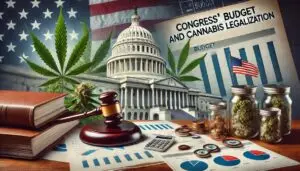Congress is directing significant attention to cannabis legalization through its appropriations process. What does this mean for you?
Dive into the latest updates on Congress appropriations and cannabis legalization. Discover how recent federal budget decisions impact cannabis reform, the Controlled Substances Act, and the CBD industry. Stay informed on the evolving landscape of cannabis laws and their effects on businesses and communities.
Congressional Appropriations and Cannabis Legalization: An Overview
Congressional appropriations deeply influence the direction of cannabis legalization across the United States. This process, an intricate mechanism involving the allocation of federal funds, directly impacts how cannabis laws are enacted and enforced. By analyzing recent amendments, you can gain a clearer perspective on how Congress is shaping the landscape of both medical and recreational cannabis through budgetary decisions.
Over the past few years, there have been significant movements towards either supporting or restricting cannabis-related activities. The appropriations process reveals much about the partisan dynamics in Congress, and how these dynamics influence legislation that either promotes or hinders cannabis legalization.
In crafting these budgets, Congress ensures that various sections, like the Rohrabacher–Farr amendment or Section 531, distinctly outline what federal funds can or cannot support. This influences whether federal interference can occur in state-run medical marijuana programs, setting a precedent for how cannabis laws develop nationwide. By staying informed on these appropriations, you can better understand and engage in the ongoing dialogue surrounding cannabis legalization.
Republican Efforts to Regulate Cannabis
Republicans have consistently championed regulatory measures aimed at controlling the cannabis landscape. These efforts often focus on limiting the Department of Justice’s ability to interfere with state medical marijuana programs, highlighting a selective approach to states’ rights.
In contrast, recent amendments for FY 2025 have sought to prevent the rescheduling of marijuana, maintaining its current classification. This restrictive stance underscores a complex interplay between supporting state autonomy and enforcing federal cannabis laws.
Recent Republican Congressional Actions
Republican lawmakers in the House noticeably shifted their focus, targeting cannabis regulations through budget appropriations. These moves aim to maintain stringent control while emphasizing a selective approach to states’ rights.
Notably, recent amendments by Republicans have sought to prevent the rescheduling of marijuana by defunding Department of Justice. This prevents states from independently modifying cannabis-related laws and keeps marijuana classified at a federal level.
The rescheduling prohibition reflects a significant, ongoing effort to control the national cannabis narrative.
The Robachor Farr amendment is crucial, restricting federal funds from interfering with state medical marijuana programs. This legislative tactic highlights the ongoing tension between federal oversight and state autonomy in cannabis legalization.
Implications for Hemp and Marijuana
For hemp, Republican amendments propose restrictions on cannabinoids like THCA and Delta-8. This impacts the industry’s ability to innovate and market various hemp products. Moreover, these changes pose significant challenges to hemp businesses trying to navigate the evolving legal landscape.
Federal funds cannot be used to move marijuana off the Controlled Substances Act. Consequently, this limits research and development opportunities and maintains current legal uncertainties around state-regulated marijuana businesses.
These developments underscore Congress’s significant influence over the future of hemp and marijuana. By understanding these budget changes, you better equip yourself to advocate effectively for sensible cannabis policies. Stay vigilant and proactive in your support of cannabis legalization.
Focus on Department of Justice Funding
In this budget cycle, Congress has taken significant steps regarding Department of Justice (DOJ) funding with implications for cannabis.
Since 2015, the Robachor Farr amendment (which is just a budget section that changes on an annual basis) has been a crucial fixture within appropriations bills, continuously blocking DOJ interference in state-sanctioned medical marijuana programs. Each year, its inclusion reflects an ongoing commitment to shield state laws from federal overreach, ensuring states can operate their medical programs without fear of federal intervention.
The Rohrabacher–Farr Amendment
The Rohrabacher–Farr amendment, also known as the Rohrabacher–Blumenauer amendment, is a piece of legislation introduced by U.S. Representative Maurice Hinchey in 2001. It prevents the Justice Department from using funds to interfere with state medical cannabis laws. After six failed attempts, it passed the House in May 2014 and became law in December 2014 as part of an omnibus spending bill.
Historical Context
Cannabis legalization in the United States has been a dynamic issue with centuries of legislative shifts.
- Early 1900s: Cannabis was widely used for medical purposes.
- 1937: The Marihuana Tax Act criminalized marijuana.
- 1970: Controlled Substances Act classified marijuana as a Schedule I drug.
- 1996: California legalized medical marijuana, spearheading state-level changes.
- 2012: Colorado and Washington legalized recreational marijuana.
Annual Renewal Requirements
Annual renewal is a critical component – as it is a new budget year.
Typically, Congress must renew the Rohrabacher–Farr amendment each year. This renewal allows for continued protection of state medical marijuana programs from federal interference, ensuring that states have the authority to regulate medical cannabis without fear of federal repercussions. Interestingly, this renewal process often highlights the ongoing policy debates and the importance of advocacy for sustained support.
Moreover, these annual renewals offer opportunities for public involvement. By engaging in the legislative process, you can influence the discourse on cannabis policy, ensuring that your voice is heard as Congress deliberates these critical protections. Keeping engaged supports the broader goal of progressive cannabis legislation.
Budget Provisions Impacting Cannabis
Recent budget provisions have significant ramifications for cannabis regulation, affecting everything from medical marijuana programs to the hemp industry. For instance, sections like 623 and 531 directly restrict cannabis rescheduling in the Republican proposed budget.
These restrictions prevent federal funds from rescheduling marijuana, limiting states’ abilities to innovate. They also protect state medical marijuana programs from federal enforcement.
Prohibition on Rescheduling Marijuana
One contentious aspect of the budget provisions is the specific prohibition on rescheduling marijuana. This restriction, found in section 623, is a clear statement against altering marijuana’s classification.
As a Schedule I substance, marijuana is deemed to have no medical value.
This provision explicitly prevents federal agencies from using budgeted funds to change marijuana’s Schedule I status, keeping it classified alongside drugs like heroin. Consequently, this hampers scientific research, medical advancements, and the broader push for legalization.
The continued enforcement of this prohibition means that any federal move to reschedule marijuana will remain a legislative impossibility for now. By freezing its classification, Congress effectively slows down the momentum towards broader cannabis reform. However, you can still make a difference. Advocate and vocalize your support for change—your contributions are invaluable to the path of progressive cannabis policy.
Constraints on Federal Interference
Section 531 is a pivotal amendment designed to limit federal interference in state cannabis laws.
This amendment is crucial for protecting state-level medical marijuana programs from federal prosecution or actions. Specifically, it prevents the Department of Justice from using allocated funds to interfere with states where medical marijuana is legal. This means states can continue to operate their medical marijuana programs without fear of federal repercussions, fostering a stable environment for patients and businesses alike.
Going forward, it’s essential to recognize the broader impact of these constraints on federal interference. They empower states to innovate and address the unique needs of their populations, serving as laboratories for progressive cannabis policies. Stay engaged, support these protective measures, and advocate for further legislative action that respects state rights and promotes cannabis legalization across the country.
Section 531: Specifics and Implications
Section 531 restricts the Department of Justice from enforcing federal marijuana laws in states with legalized medical marijuana programs. This provision is crucial for protecting state autonomy and respecting voters’ choices.
SEC. 531. (a) None of the funds made available under this Act to the Department of Justice may be used, with respect to any of the States of Alabama, Alaska, Arizona, Arkansas, California, Colorado, Connecticut, Delaware, Florida, Georgia, Hawaii, Illinois, Indiana, Iowa, Kentucky, Louisiana, Maine, Maryland, Massachusetts, Michigan, Minnesota, Mississippi, Missouri, Montana, Nevada, New Hampshire, New Jersey, New Mexico, New York, North Carolina, North Dakota, Ohio, Oklahoma, Oregon, Pennsylvania, Rhode Island, South Carolina, South Dakota, Tennessee, Texas, Utah, Vermont, Virginia, Washington, West Virginia, Wisconsin, and Wyoming, or with respect to the District of Columbia, the Commonwealth of the Northern Mariana Islands, the United States Virgin Islands, Guam, or Puerto Rico, to prevent any of them from implementing their own laws that authorize the use, distribution, possession, or cultivation of medical marijuana.
(b) Funds made available under this Act to the Department of Justice may be used to enforce violations of 21 U.S.C. 860.
Affecting “no enforcement” near sensitive areas, Section 531 exemplifies a balanced approach to cannabis regulation. It safeguards both state innovation and community welfare.
Proximity Restrictions to Schools
Proximity restrictions ensure medical marijuana dispensaries cannot operate near schools to protect children and the community.
- Dispensaries must be located a specific distance from school property lines.
- Local regulations define “school zones” to enforce these restrictions.
- Violations can lead to severe penalties for dispensary owners.
- Regular inspections verify compliance with proximity regulations.
These restrictions align with community safety standards and local governance.
Following these rules, dispensaries contribute positively to their communities while maintaining legal compliance.
Comparisons to Local Regulations
Across various states, similar provisions exist, reflecting the overarching federal mandate and local willingness to balance cannabis access with public safety.
For instance, many states implement a required distance between dispensaries and sensitive locations like schools and playgrounds, mirroring the federal Section 531’s intent. These state-level regulations often mirror or exceed federal guidelines to ensure that medical marijuana programs do not infringe upon community safety or societal norms.
Political Maneuvering in Cannabis Legislation
The political landscape surrounding cannabis legislation is a maze of strategic maneuvers, often driven by various underlying motivations. Lawmakers from both sides of the aisle routinely introduce amendments and budget provisions to either support or suppress cannabis reforms, depending on their political agendas and constituent pressures.
SEC. 623. None of the funds appropriated or other wise made available by this Act may be used to reschedule marijuana (as such term is defined in section 102 of the Controlled Substances Act (21 U.S.C. 802)) or to remove marijuana from the schedules established under section 202 of the Controlled Substances Act (21 U.S.C. 812).
In recent years, this tug-of-war has intensified, with figures like Republican Mary Miller from Illinois attempting to tighten regulations on the hemp industry through new amendments.
Historical Use of Appropriations
The historical use of appropriations to influence cannabis legalization has been a strategic tool in the legislative process.
- 2003: Introduction of the first bipartisan amendment to limit DEA’s interference with state medical marijuana laws.
- 2014: Passage of the Rohrabacher-Farr amendment, restricting federal funds for interfering in state medical marijuana programs.
- 2018: Introduction of the Joyce Amendment, aimed at protecting all state-level cannabis programs from federal interference.
- 2020: Renewal and expansion of appropriations protections to include hemp industry regulations.
These appropriations have set crucial precedents for state versus federal control of cannabis laws.
By leveraging budget appropriations, Congress can effectively shape the legality and accessibility of cannabis across the United States.
Republican Amendments and Their Impact
Recent Republican amendments have significantly influenced the direction of cannabis legislation through budget appropriations.
- Section 623: Prevents the rescheduling of marijuana.
- Section 531: Limits the Department of Justice’s ability to enforce federal marijuana laws in states with legal medical marijuana.
- Mary Miller Amendment: Targets the hemp industry by banning cannabinoids such as THCA and Delta-8.
Federal vs. State Tensions
The ongoing debate between federal and state regulations creates a complex and often contradictory landscape for cannabis laws.
- Federal Prohibition: Marijuana remains a Schedule I substance under federal law, with severe legal restrictions.
- State Laws: Many states have legalized cannabis for medical or recreational use, creating a patchwork of regulations.
- Funding Restrictions: Federal appropriations often include provisions that restrict DOJ’s ability to interfere with state cannabis laws.
- Advocacy and Lobbying: Continuous advocacy at both state and federal levels is crucial to navigating these tensions.
These conflicting laws cause significant legal and operational challenges for cannabis businesses.
Understanding the nuances and implications of these regulations is key for stakeholders in the cannabis industry.
Hypocrisy in States’ Rights Arguments
When discussing states’ rights regarding cannabis laws, certain politicians paint a picture of unwavering support for decentralized governance. Yet, a closer examination reveals stark inconsistencies in these positions.
States’ rights conservatives often claim to support state-level decision-making. However, these same voices sometimes push for federal restrictions on cannabis, contradicting their advocacy for state autonomy.
This contradiction is evident in recent appropriations bills that include provisions to halt federal interference with state laws while simultaneously restricting states from rescheduling cannabis.
For true progress, it’s vital to challenge these double standards. Empower state-level experimentation without selective federal constraints.
Impact on Medical Marijuana Programs
The new appropriations provisions create a significant barrier for state medical marijuana programs, preventing them from rescheduling cannabis or expanding their scope. This federal restraint limits innovation, progress, and state-level autonomy.
Nevertheless, the Rohrabacher–Farr amendment offers some relief by prohibiting federal enforcement against state-legal medical marijuana operations, ensuring states can continue providing patient access.
States Affected by New Provisions

These jurisdictions have lawful medical marijuana programs that must navigate these budget constraints.
Despite federal prohibitions on rescheduling cannabis, the Rohrabacher–Farr amendment supports these states by protecting their medical marijuana initiatives from federal interference.
However, the restrictions on proximity to schools and colleges mean states must carefully manage where dispensaries operate. This nuanced landscape necessitates vigilant local regulation while maximizing the benefits of medical marijuana programs. Embrace this challenge, knowing each effort pushes us closer to true cannabis reform.
Enforcement Restrictions
The new budget introduces crucial enforcement restrictions on federal actions against state-legal cannabis programs.
- Rohrabacher–Farr Amendment: Limits federal interference with state medical marijuana laws.
- Section 531: Prohibits enforcement within certain proximities to schools and colleges.
- Section 623: Restricts rescheduling marijuana from the Controlled Substances Act.
- States Included: Includes 38 states, District of Columbia, Guam, Virgin Islands, Puerto Rico, and Northern Mariana Islands.
These restrictions protect state laws, providing significant relief for local cannabis operations.
Federal and state law conflicts still pose challenges, but these restrictions offer substantial protection for state endeavors.
Political Influence and Cannabis Policy
Political influence significantly shapes cannabis policy-making and impacts the direction of the industry.
On both federal and state levels, various political actors (both individuals and parties) leverage their positions to influence cannabis legislation, often driven by differing motives and agendas. This creates a complex and dynamic policy environment.
The terms “pro-cannabis” and “anti-cannabis” thus vary significantly depending on the ‘political climate’.
Advocacy and Public Involvement
Grassroots activism remains vital in shaping cannabis legislation, driving change from the ground up. Engaging with local and federal legislators through letters, emails, and social media amplifies your voice, urging lawmakers to consider public opinion in policy decisions.
By participating in organizations like NORML or the Drug Policy Alliance, you can join a network of advocates. These groups offer resources and action plans, helping coordinate public efforts effectively. Staying informed, attending meetings, and voicing support are essential for progressing toward comprehensive cannabis legalization.
Conclusion and Call to Action
Your involvement is crucial in shaping cannabis legislation.
By staying informed about congressional appropriations and cannabis legalization, you become a powerful advocate for change. Understanding the various amendments and provisions, such as Section 531 and the Rohrabacher–Farr amendment, equips you with the knowledge needed to engage effectively with your representatives.
Furthermore, your voice matters. Reach out to your local officials, participate in public forums, and show your support for pro-cannabis policies. Direct engagement with your representatives can influence their stance and push for legislative reforms that benefit the cannabis community at large.
Remember, unity and collaboration are key. Join forces with advocacy groups and campaigns to amplify your influence. Together, we can drive the momentum needed to achieve meaningful changes in cannabis laws. Your active participation today can help create a more progressive and equitable future for cannabis legalization.




